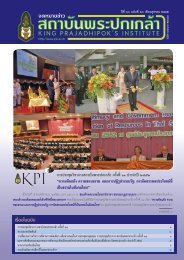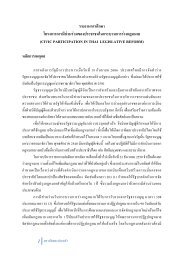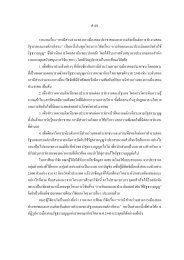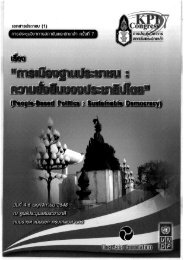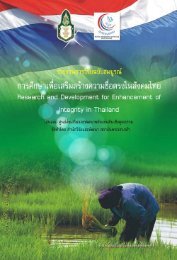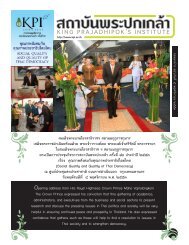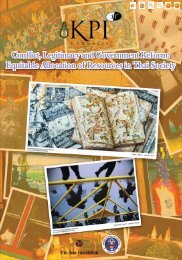SUFFiciENcy EcONOMy ANd GRASSROOtS DEvElOPMENt
SUFFiciENcy EcONOMy ANd GRASSROOtS DEvElOPMENt
SUFFiciENcy EcONOMy ANd GRASSROOtS DEvElOPMENt
You also want an ePaper? Increase the reach of your titles
YUMPU automatically turns print PDFs into web optimized ePapers that Google loves.
The Meaning of Sufficiency Economy <br />
International Conference<br />
221<br />
characteristic of many women who learned to subordinate their own desires to help<br />
their parents and later their husbands and children. This ethic would enable both<br />
men and women to work to improve the conditions of their lives and those of their<br />
families as they took advantage of new opportunities created by an expanding Thai<br />
economy. <br />
For villagers to enter successfully into the capitalist economy of Thailand, they<br />
also needed basic literacy in standard Thai and basic numeracy. These skills they<br />
acquired from government-sponsored primary schooling. Ban Nông Tün, like most<br />
villages in northeastern Thailand, had had a government school since the mid-1930s<br />
and since the late 1940s almost every villager completed the four years of<br />
compulsory primary education. From schooling villagers learned to see themselves<br />
as ‘Thai’ even though culturally and linguistically they were ‘Lao’. This<br />
identification together with competence in standard Thai and in the fundamentals of<br />
arithmetic learned in school enabled many villagers to interact in a Thai-national<br />
dominated world (see Keyes 1991a).<br />
Village school in the grounds of the wat (Buddhist temple-monastery),<br />
1963 (photo by Jane Keyes)<br />
As the Thai economy expanded rapidly from the 1960s on, more and more<br />
villagers – including women – would follow their older siblings and parents to<br />
Bangkok and elsewhere to find work.<br />
Re-orientation of the Village toward ‘Development’<br />
In the 1960s villagers wholeheartedly embraced a new orientation toward the<br />
world – namely ‘development’ (kãnphatthanã). This term and what has come to be<br />
called the ‘development era’ (samai phatthanã) in Thailand is usually associated <br />
with government policies introduced at the time when Field Marshal Sarit Thanarat<br />
was the country’s military dictator. There is no question but that some of the<br />
development programs introduced by the government over the next decades –<br />
especially road-building, rural electrification, and support for industrialization –<br />
greatly facilitated growth not only of the national economy but also the economy of<br />
rural northeastern Thailand. It was, nonetheless, actions taken by villagers<br />
themselves which brought the radical changes to rural lifestyles that they came to<br />
associate with ‘development’.<br />
One of the most profound changes in village life occurred when village women<br />
began to adopt birth control methods. They first did this in the 1970s when it was<br />
government policy to promote more births. By the mid-1980s few women were<br />
having more than two children. The dramatic change in population in the village can<br />
be seen in the following tables comparing population distributions in 1963, 1980 and<br />
2005.



